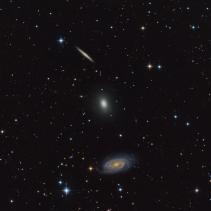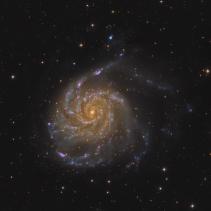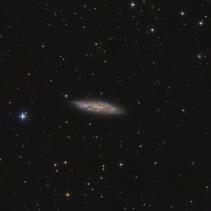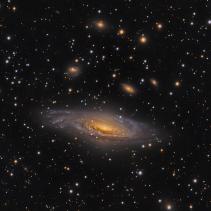Galaxies
NGC 5981, NGC 5982, NGC 5985
To deep sky observers, the group of NGC 5985, NGC 5982 and NGC 5981 is commonly known as the “Draco Trio”. Two barred spirals at different angles and a face on elliptical all in the same field of view is a rare sight and makes for a beautiful celestial portrait. The beautiful spiral is NGC 5985. The proper designation for the elliptical galaxy is NGC 5982. The catalog number for the edge-on is NGC 5981. While these galaxies span huge amounts of light years apart, they share telescopic space at RA: 15h 38m 40s Dec: +59°21’22” as a center and share photons in the eyepiece at around 25 arc minutes. While the Draco group is far too small to be considered its own galaxy cluster and has never been classified as a compact group, oddly enough all three are around 100 million light years away from the Sol System.
L = 16* 1200 sec. bin1, RGB = 9 * 900 sec. bin2, in the each filters.
Total time - 12 hours
Pixinsight 1.8, Lightroom.
M 101
The Pinwheel Galaxy (also known as Messier 101 or NGC 5457) is a face-on spiral galaxy distanced 21 million light-years (six megaparsecs) away from earth in the constellation Ursa Major. First discovered by Pierre Méchain on March 27, 1781, it was communicated to Charles Messier who verified its position for inclusion in the Messier Catalogue as one of its final entries.
M101 is a large galaxy comparable in size to the Milky Way. With a diameter of 170,000 light-years it is roughly equal the size of the Milky Way. It has a disk mass on the order of 100 billion solar masses, along with a small central bulge of about 3 billion solar masses.
M101 is noted for its high population of H II regions, many of which are very large and bright. H II regions usually accompany the enormous clouds of high density molecular hydrogen gas contracting under their own gravitational force where stars form. H II regions are ionized by large numbers of extremely bright and hot young stars; those in M101 are capable of creating hot superbubbles. In a 1990 study, 1264 H II regions were cataloged in the galaxy. Three are prominent enough to receive New General Catalogue numbers - NGC 5461, NGC 5462, and NGC 5471.
L = 16 * 1200 sec. bin1, RGB = 8 * 900 sec. bin2, in the each filters.
Total time - 14 hours
Pixinsight 1.8 and Lightroom.
M 108
Messier 108 (also known as NGC 3556) is a barred spiral galaxy in the constellation Ursa Major. It was discovered by Pierre Méchain in 1781 or 1782. From the perspective of the Earth, this galaxy is seen almost edge-on.
This galaxy is an isolated member of the Ursa Major Cluster of galaxies in the Virgo supercluster. It has a morphological classification of type SBbc in the de Vaucouleurs system, which means it is a barred spiral galaxy with somewhat loosely wound arms. The maximum angular size of the galaxy in the optical band is 11′.1 × 4′.6, and it is inclined 75° to the line of sight.
This galaxy has an estimated mass of 125 billion times the mass of the Sun and includes about 290 ± 80 globular clusters. Examination of the distribution of neutral hydrogen in this galaxy shows shells of expanding gas extending for several kiloparsecs, known as H1 supershells. These may be driven by bursts of star formation activity, resulting in supernovae explosions. Alternatively they may result from an infall of gas from outside the galaxy or by radio jets.
L = 16 * 900 sec. bin1, RGB = 9 * 600 sec. bin2, in the each filters.
Total time - 8.5 hours.
Pixinsight 1.8
NGC 7331
NGC 7331 (also known as Caldwell 30) is a unbarred spiral galaxy about 40 million light-years (12 Mpc) away in the constellation Pegasus. It was discovered by William Herschel in 1784. NGC 7331 is the brightest member of the NGC 7331 Group of galaxies. The other members of the group, visible to the left of NGC 7331 in the main image, are lenticular or unbarred spirals NGC 7335 and 7336, barred spiral galaxy NGC 7337 and elliptical galaxy NGC 7340. These galaxies lie at distances of approximately 332, 365, 348 and 294 million light years, respectively. [4] In both visible light and infrared photos of the NGC 7331, the core of the galaxy appears to be slightly off-center, with one side of the disk appearing to extend further away from the core than the opposite side.
The galaxy is similar in size and structure to the galaxy we inhabit, and is often referred to as "the Milky Way's twin", although recent discoveries regarding the structure of the Milky Way may call this similarity into doubt, particularly because the Milky Way is believed to be a barred spiral, compared to the unbarred status of NGC 7331.
FWHM of subframes in L are from 1.83″ to 2.74″, L - 2.20″.
L = 32 * 1200 sec. bin1, RGB = 8 * 600 sec. bin2, in each filters.
Total time - 14 hours.
Pixinsight 1.8




